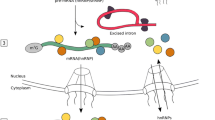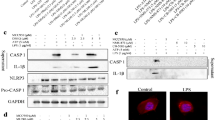Abstract
The broad-complex, tramtrack, and bric-a-brac/poxvirus and zinc finger domain-containing protein tumor necrosis factor, alpha-induced protein 1 (TNFAIP1) was first identified as a gene whose expression can be induced by the tumor necrosis factor alpha. Some studies showed that TNFAIP1 may function in DNA replication, apoptosis and human diseases. However, the definite functions and the mechanisms of TNFAIP1 are poorly known. In this study, we performed a yeast two-hybrid assay and used TNFAIP1 as the bait to screen human brain cDNA library. Potassium channel tetramerisation domain containing 10 (KCTD10) was identified as TNFAIP1-interacting partner. The KCTD10–TNFAIP1 interaction was then confirmed by the in vitro GST pull-down assays and the in vivo co-immunoprecipitation and colocalization assays. In addition, protein degradation and ubiquitin assays revealed TNFAIP1 overexpression resulted in ubiquitin-mediated degradation of KCTD10 proteins, which was significantly alleviated with the proteasome inhibitor MG132 treatment. Furthermore, transient transfection assays with two reporters showed that TNFAIP1 and KCTD10 inhibited the transcriptional activities of nuclear factor kappa B (NF-κB) and activating protein-1 reporters. Taken together, our results indicated the novel interaction and function between KCTD10 and TNFAIP1 in human PDIP1 family.






Similar content being viewed by others
References
He H, Tan CK, Downey KM, So AG (2001) A tumor necrosis factor alpha- and interleukin 6-inducible protein that interacts with the small subunit of DNA polymerase delta and proliferating cell nuclear antigen. Proc Natl Acad Sci USA 98:11979–11984
Zhou J, Hu X, Xiong X, Liu X, Liu Y, Ren K, Jiang T, Hu X, Zhang J (2005) Cloning of two rat PDIP1 related genes and their interactions with proliferating cell nuclear antigen. J Exp Zool A Comp Exp Biol 303:227–240
Zhou J, Ren K, Liu X, Xiong X, Hu X, Zhang J (2005) A novel PDIP1-related protein, KCTD10, that interacts with proliferating cell nuclear antigen and DNA polymerase delta. Biochim Biophys Acta 1729:200–203
Wang Y, Zheng Y, Luo F, Fan X, Chen J, Zhang C, Hui R (2009) KCTD10 interacts with proliferating cell nuclear antigen and its down-regulation could inhibit cell proliferation. J Cell Biochem 106:409–413
Liu M, Sun Z, Zhou A, Li H, Yang L, Zhou C, Liu R, Hu X, Zhou J, Xiang S, Zhang J (2010) Functional characterization of the promoter region of human TNFAIP1 gene. Mol Biol Rep 37:1699–1705
Yang L, Liu N, Hu X, Zhang W, Wang T, Li H, Zhang B, Xiang S, Zhou J, Zhang J (2010) CK2 phosphorylates TNFAIP1 to affect its subcellular localization and interaction with PCNA. Mol Biol Rep 37:2967–2973
Locksley RM, Killeen N, Lenardo MJ (2001) The TNF and TNF receptor superfamilies: integrating mammalian biology. Cell 104:487–501
Mencoboni M, Lerza R, Bogliolo G (1992) Tumor necrosis factor: a cytokine with multiple actions. Recent Prog Med 83:15–17
Wolf FW, Marks RM, Sarma V, Byers MG, Katz RW, Shows TB, Dixit VM (1992) Characterization of a novel tumor necrosis factor-alpha-induced endothelial primary response gene. J Biol Chem 267:1317–1326
Yang L, Zhou A, Li H, Zhang W, Wu Y, Zhang J, Han M (2006) Expression profile in the cell lines of human TNFAIP1 gene. Hereditas 28:918–922
Xiong X, Liu X, Hu X, Jiang X, Liu Y, Zhang J (2004) Differential expression analysis of B12 gene after mouse partial hepatectomy. J Nat Sci Hunan Norm Univ 27:71–74
Liu XW, Lu FG, Zhang GS, Wu XP, You Y, Ouyang CH, Yang DY (2004) Proteomics to display tissue repair opposing injury response to LPS-induced liver injury. World J Gastroenterol 10:2701–2705
Lin MC, Lee NP, Zheng N, Yang PH, Wong OG, Kung HF, Hui CK, Luk JM, Lau GK (2005) Tumor necrosis factor-alpha-induced protein 1 and immunity to hepatitis B virus. World J Gastroenterol 11:7564–7568
Link CD, Taft A, Kapulkin V, Duke K, Kim S, Fei Q, Wood DE, Sahagan BG (2003) Gene expression analysis in a transgenic caenorhabditis elegans Alzheimer’s disease model. Neurobiol Aging 24:397–413
Zhang W, Zhou A, Yang L, Li H, Zhang J (2006) Expression and preparation of antiserum of human KCTD10 and its expression profile in the cell lines. Acta Laser Biol Sinica 15:496–500
Ding X, Fan C, Zhou J, Zhong Y, Liu R, Ren K, Hu X, Luo C, Xiao S, Wang Y, Feng D, Zhang J (2006) GAS41 interacts with transcription factor AP-2beta and stimulates AP-2beta-mediated transactivation. Nucleic Acids Res 34:2570–2578
Ding X, Luo C, Zhou J, Zhong Y, Hu X, Zhou F, Ren K, Gan L, He A, Zhu J, Gao X, Zhang J (2009) The interaction of KCTD1 with transcription factor AP-2alpha inhibits its transactivation. J Cell Biochem 106:285–295
Kim DM, Chung KS, Choi SJ, Jung YJ, Park SK, Han GH, Ha JS, Song KB, Choi NS, Kim HM, Won M, Seo YS (2009) RhoB induces apoptosis via direct interaction with TNFAIP1 in HeLa cells. Int J Cancer 125:2520–2527
Sun JK, Zhang B, Zhang J, Zhou JL (2007) Preparation of mouse KCTD10 antibody and expression analysis of KCTD10 in neuroepithelium of neural tube and dorsal root ganglion. Sheng Wu Gong Cheng Xue Bao 23:1011–1016
Ahmad KF, Engel CK, Prive GG (1998) Crystal structure of the BTB domain from PLZF. Proc Natl Acad Sci USA 95:12123–12128
Cullinan SB, Gordan JD, Jin J, Harper JW, Diehl JA (2004) The Keap1-BTB protein is an adaptor that bridges Nrf2 to a Cul3-based E3 ligase: oxidative stress sensing by a Cul3-Keap1 ligase. Mol Cell Biol 24:8477–8486
Kwon JE, La M, Oh KH, Oh YM, Kim GR, Seol JH, Baek SH, Chiba T, Tanaka K, Bang OS, Joe CO, Chung CH (2006) BTB domain-containing speckle-type POZ protein (SPOP) serves as an adaptor of daxx for ubiquitination by Cul3-based ubiquitin ligase. J Biol Chem 281:12664–12672
Furukawa M, Xiong Y (2005) BTB protein Keap1 targets antioxidant transcription factor Nrf2 for ubiquitination by the cullin 3-Roc1 ligase. Mol Cell Biol 25:162–171
Bayon Y, Trinidad AG, de la Puerta ML, Del Carmen Rodriguez M, Bogetz J, Rojas A, De Pereda JM, Rahmouni S, Williams S, Matsuzawa S, Reed JC, Crespo MS, Mustelin T, Alonso A (2008) KCTD5, a putative substrate adaptor for cullin3 ubiquitin ligases. FEBS J 275:3900–3910
Correale S, Pirone L, Di Marcotullio L, De Smaele E, Greco A, Mazza D, Moretti M, Alterio V, Vitagliano L, Di Gaetano S, Gulino A, Pedone EM (2011) Molecular organization of the cullin E3 ligase adaptor KCTD11. Biochimie 93:715–724
Li X, Peng H, Schultz DC, Lopez-Guisa JM, Rauscher FJ 3rd, Marmorstein R (1999) Structure-function studies of the BTB/POZ transcriptional repression domain from the promyelocytic leukemia zinc finger oncoprotein. Cancer Res 59:5275–5282
Ding XF, Luo C, Ren KQ, Zhang J, Zhou JL, Hu X, Liu RS, Wang Y, Gao X, Zhang J (2008) Characterization and expression of a human KCTD1 gene containing the BTB domain, which mediates transcriptional repression and homomeric interactions. DNA Cell Biol 27:257–265
Prajapati B, Singhal M, Yashwant, Sharma GN, Gupta V (2010) Role of NFkB in various immunological & inflammatory disorders. Int J Toxicol Pharmacol Res 2:35–39
Tian B, Brasier AR (2003) Identification of a nuclear factor kappa B-dependent gene network. Recent Prog Horm Res 58:95–130
Td G (2006) Introduction to NF-κB players, pathways, perspectives. Oncogene 25:6680–6684
Glover JNHS (1995) Crystal structure of the heterodimeric bZIP transcription factor c-Fos-c-Jun bound to DNA. Nature 373:257–261
Ameyar MWM, Weitzman JB (2003) A role for AP-1 in apoptosis: the case for and against. Biochimie 85:747–752
Li Q, Verma IM (2002) NF-kappaB regulation in the immune system. Nat Rev Immunol 2:725–734
Shaulian E, Karin M (2002) AP-1 as a regulator of cell life and death. Nat Cell Biol 4:E131–E136
Fujioka S, Niu J, Schmidt C, Sclabas GM, Peng B, Uwagawa T, Li Z, Evans DB, Abbruzzese JL, Chiao PJ (2004) NF-kappaB and AP-1 connection: mechanism of NF-kappaB-dependent regulation of AP-1 activity. Mol Cell Biol 24:7806–7819
Wu HM, Wen HC, Lin WW (2002) Proteasome inhibitors stimulate interleukin-8 expression via ras and apoptosis signal-regulating kinase-dependent extracellular signal-related kinase and c-Jun N-terminal kinase activation. Am J Respir Cell Mol Biol 27:234–243
Ortiz-Lazareno PC, Hernandez-Flores G, Dominguez-Rodriguez JR, Lerma-Diaz JM, Jave-Suarez LF, Aguilar-Lemarroy A, Gomez-Contreras PC, Scott-Algara D, Bravo-Cuellar A (2008) MG132 proteasome inhibitor modulates proinflammatory cytokines production and expression of their receptors in U937 cells: involvement of nuclear factor-kappaB and activator protein-1. Immunology 124:534–541
Acknowledgments
We thank Dr. Yue Xiong (University of North Carolina at Chapel Hill), for providing Cul-3 and ubiquitin constructs. This work was supported in part by the 973 project of Ministry of Science and Technique of China (No. 2009ZX08010-024B), the Program for The National Natural Science Foundation of China (No. 30900827) and the Science & Technology Department of Hunan Province (No. 2011FJ3140, No. 2011TT2008).
Author information
Authors and Affiliations
Corresponding author
Additional information
Xiang Hu, Feng Yan and Fangmei Wang contributed equally to this study.
Rights and permissions
About this article
Cite this article
Hu, X., Yan, F., Wang, F. et al. TNFAIP1 interacts with KCTD10 to promote the degradation of KCTD10 proteins and inhibit the transcriptional activities of NF-κB and AP-1. Mol Biol Rep 39, 9911–9919 (2012). https://doi.org/10.1007/s11033-012-1858-7
Received:
Accepted:
Published:
Issue Date:
DOI: https://doi.org/10.1007/s11033-012-1858-7




